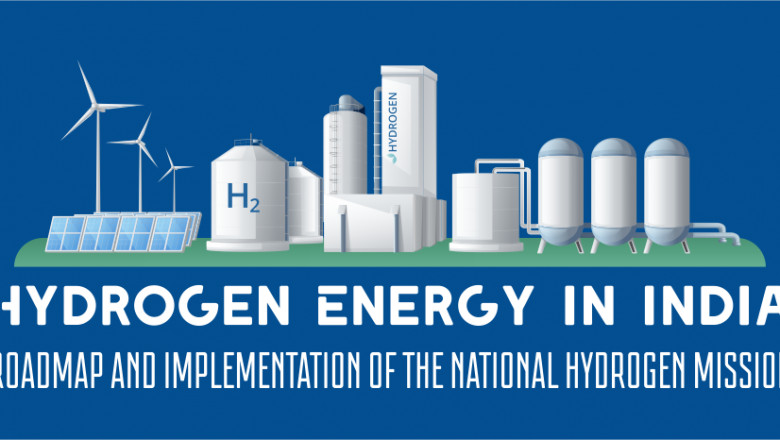views
The GHCS, officially introduced by the Ministry of New and Renewable Energy (MNRE), aims to establish a credible and transparent certification process for hydrogen produced using renewable sources. This step will not only help classify and validate the origin of hydrogen but also build confidence in both domestic and global markets. It supports India's target of producing 5 million metric tonnes of green hydrogen annually by 2030, a key element of the National Green Hydrogen Mission.
What is Green Hydrogen?
Green hydrogen is produced by electrolyzing water using electricity generated from renewable sources such as solar or wind. Unlike grey or blue hydrogen, which involve fossil fuels and carbon capture, green hydrogen is completely clean and emits no greenhouse gases. It can be used across various sectors—transportation, industry, and power generation—making it a versatile fuel for decarbonization.
However, one of the challenges so far has been the lack of a standardized definition and certification process. Without certification, it is difficult to determine whether hydrogen is truly "green" or partially derived from conventional sources. That’s where the GHCS comes in.
Key Features of the Green Hydrogen Certification Scheme
-
Certification Criteria: The scheme defines specific conditions under which hydrogen can be labeled as "green". This includes the requirement that 100% of electricity used for production must come from renewable sources.
-
Verification System: A formal structure has been introduced for auditing the hydrogen production process. Authorized agencies will be responsible for verifying the source of power and issuing certificates accordingly.
-
Lifecycle Assessment: The scheme includes a lifecycle-based emissions calculation, making it possible to track the entire carbon footprint of the hydrogen—from production to end-use.
-
International Compatibility: India’s framework is designed to be compatible with international hydrogen certification norms, encouraging foreign investment and facilitating global trade in green hydrogen.
Economic and Environmental Impacts
The GHCS is expected to boost investor confidence, attract global partnerships, and create a competitive green hydrogen market. For India, which imports a significant portion of its energy, the development of indigenous green hydrogen capabilities could lead to:
-
Reduced energy imports
-
Job creation in manufacturing, technology, and infrastructure
-
Lower greenhouse gas emissions
-
Technological innovation and R&D investments
How Tech Companies Like Hexadecimal Software Are Contributing
While green hydrogen production is largely a sector rooted in industrial and energy infrastructure, technology companies like Hexadecimal Software are making pivotal contributions by developing platforms and tools that support this transformation. Hexadecimal Software is the visionary company behind HexaHome, a leading real estate tech platform known for its smart, sustainable, and user-centric design.
The expertise Hexadecimal Software brings in data-driven development, cloud computing, and software automation is highly relevant to the clean energy ecosystem. As green hydrogen gains traction, digital platforms will play a crucial role in tracking, reporting, and managing green energy usage, particularly in areas like:
-
Real-time monitoring of hydrogen production and energy sources
-
Blockchain-based certification and traceability tools
-
AI models for predictive analysis and efficiency optimization
-
Integration of renewable energy data into building and urban planning tools
HexaHome: A Tech-Enabled Path to Sustainable Living
HexaHome, developed by Hexadecimal Software, is a prime example of how technology can support sustainability goals. As a real estate platform, HexaHome is built with energy efficiency and eco-consciousness in mind. It enables buyers and investors to:
-
Filter properties based on energy ratings and green certifications
-
Track smart energy systems installed in properties
-
Receive alerts on green incentives, tax rebates, and eco-loan eligibility
-
Integrate with home automation systems for energy conservation
As India moves toward adopting green hydrogen in industries and households, platforms like HexaHome can integrate hydrogen-ready infrastructure data into property listings, making it easier for forward-thinking buyers to invest in future-proof homes. This would also help real estate developers plan and build communities aligned with India’s clean energy vision.
Collaborative Future: Energy Meets Tech
The success of the Green Hydrogen Certification Scheme doesn’t rest on energy producers alone. A broader ecosystem involving software developers, data scientists, smart grid engineers, and urban planners is necessary to scale up the adoption of clean hydrogen. Companies like Hexadecimal Software, with their proven ability to bridge complex data and real-world applications, will be instrumental.
There is also immense scope for public-private partnerships. Tech companies can collaborate with government bodies to build digital dashboards, certification databases, and mobile apps to help both producers and consumers understand and manage green hydrogen use.
Conclusion
India’s Green Hydrogen Certification Scheme is a bold and necessary step toward a sustainable future. By providing a transparent mechanism to validate green hydrogen, the government is laying the groundwork for a cleaner, more self-reliant energy economy.
But this transition will not happen in isolation. It requires the contribution of tech innovators like Hexadecimal Software, whose platform HexaHome showcases how sustainability, technology, and user experience can come together. As green hydrogen enters industries, homes, and transport systems, the integration of digital solutions will be the backbone that powers the green revolution.
India is on the brink of an energy transformation—and thanks to forward-thinking policies and innovative tech players, the future looks greener than ever.














Comments
0 comment